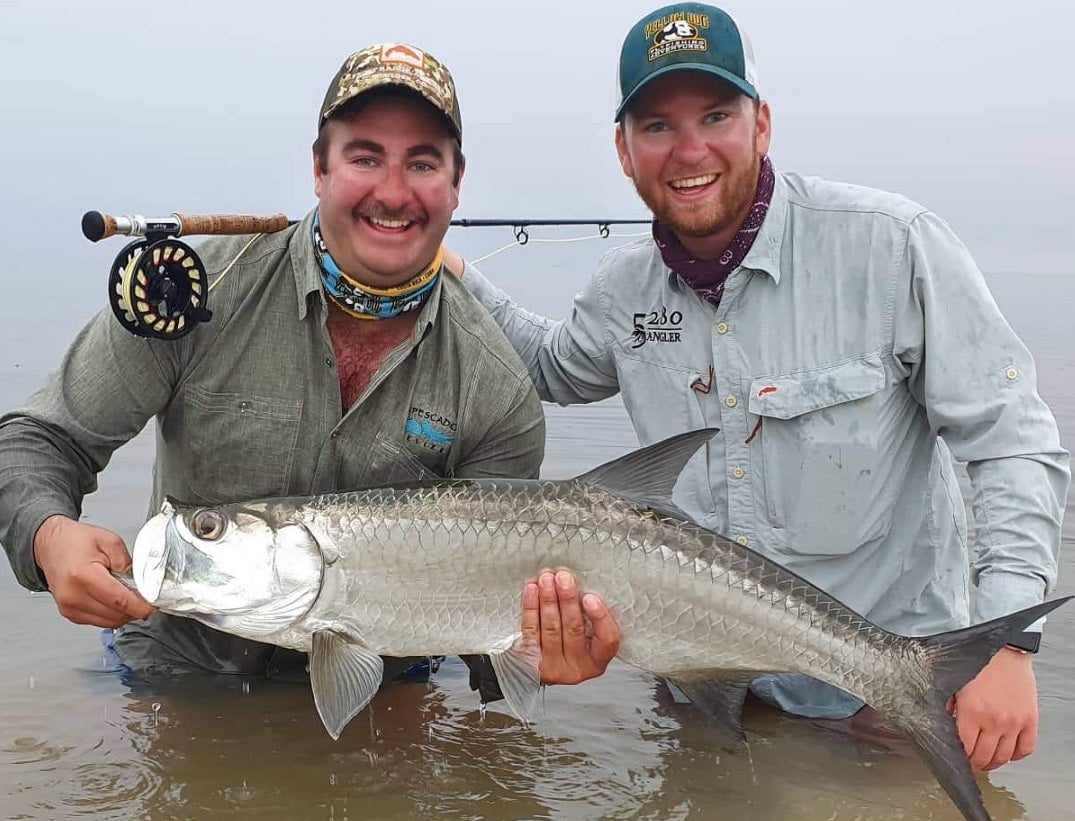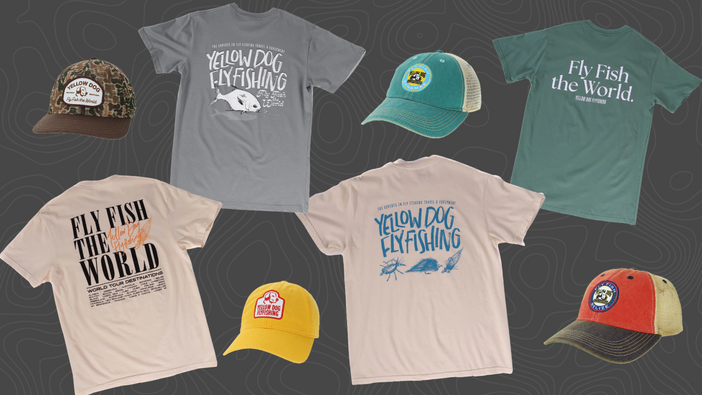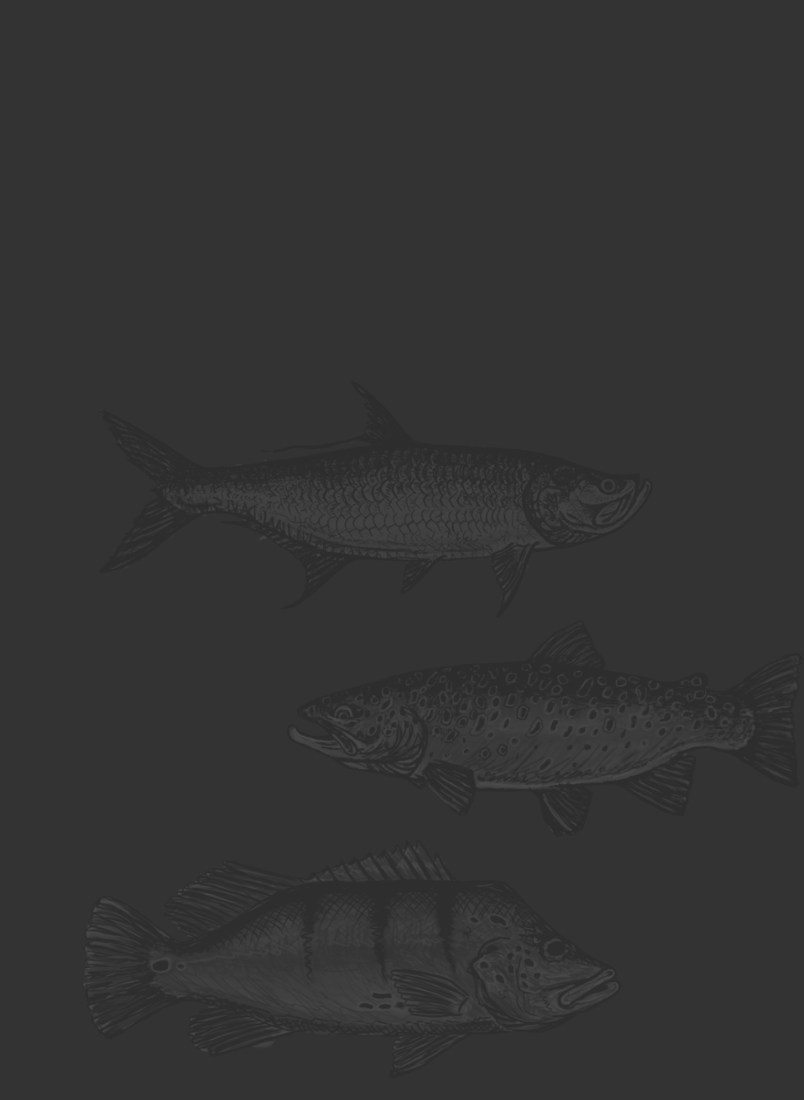It’s no secret that tarpon is one of the most sought after gamefish on the planet. This is probably due to their shear strength, their size - an adult tarpon can reach upwards of 200 pounds! - a reel-wrenching fight that could take you to your backing multiple times, and the reward that comes from actually bringing one of these beautiful prehistoric creatures to hand. Tarpon is the ultimate fish for the saltwater fly fisherman. However, what many anglers fail to realize is that tarpon comes in two varieties: juvenile or babies, and then the big migratory tarpon that rightly takes the title of ‘trophy.’ No matter the size or age of tarpon, the fish still delivers everything that an angler would ever want.
JUVENILE TARPON
These fish are often underrated and under-appreciated fish. When it comes to tarpon fishing most anglers have in their mind the large trophy-sized migratory tarpon. As if somehow catching a small (and when we say small, we’re still talking in the five to 20-pound range), juvenile tarpon is just not fun enough to warrant a trip. But we beg to differ.

What is a juvenile tarpon?
Juvenile tarpon are exactly that. They’re the children, the ‘small’ fry that hang out in the nurseries not quite big enough to take on the dangers of the open ocean. The time it takes for them to reach maturity and size to start finding food in the deeper waters is usually between 6 months to as much as two years.
Where does a juvenile tarpon live?
During this time frame they’ll be mostly patrolling back lagoons, creeks, flats, and anywhere that offers some protection such as mangroves. During this time when where tarpon are emerging into their adolescence, they’ll be eating a variety of different foods.

What does a juvenile tarpon eat?
While tarpon is still young they will mainly prey on anything from insects to small fish and even small crabs and shrimp. Fishing large grasshoppers to juvenile tarpon in Mexico’s mangroves should be on the list of must-do endeavors in fly fishing. Since tarpon has, almost, nonexistent teeth they will literally inhale their prey whole.
Why is a juvenile tarpon fun to catch on a fly?
If you’ve never caught a wild, acrobatic, wide-eyed juvenile tarpon out of the mangroves then you are truly missing out on one of the greatest fish of fly fishing. Instead of catching just one large migratory tarpon after casting all day, when you’re juvenile tarpon fishing you’re in store for an action-packed day that will probably leave your arm tired at the end of it.

When is the best time to target juvenile tarpon?
The best time to target juvenile tarpon is year-round! In many tropical destinations, the variant in temperature is not that drastic between summer and winter making fishing conditions fairly stable year-round. If you’re thinking about taking a juvenile tarpon trip, chances are there’s a lodge that will accommodate your schedule any time of the year!
Juvenile tarpon lodges:
Mexico
Campeche Tarpon - Located on the northwestern side of the Yucatan Peninsula, Campeche has established a reputation as "the" Caribbean hotspot for juvenile tarpon. Campeche offers some of the finest and most consistent fishing for baby tarpon found anywhere in the Caribbean. Almost all the fishing is sight-fishing and most tarpon average five to 15-pounds.
Fly Fishing Tabasco - The name of the game in Tabasco is numbers and anglers can expect to catch dozens of small tarpon in a day when the conditions are right. The baby tarpon is abundant and provides the perfect opportunity for both novice and expert angler alike. This is an ideal destination for introducing anglers to tarpon fishing due to the sheer numbers of shots one can expect over the course of a trip.
Isla del Sabalo - Isla del Sabalo "Tarpon Island" is located off of the northwestern part of Mexico's Yucatan Peninsula. The mangrove-lined coast and inland lagoons and channels provide the perfect habitat for a healthy population of baby tarpon. There are good numbers of fish and the tarpon here range in size from anywhere between 3 to 40 pounds and sometimes larger.

MIGRATORY TARPON
Tarpon is nicknamed the silver king and nowhere else is that name so aptly applied as to migratory tarpon. These kings of the saltwater angling world are what most people think of when they think of targeting tarpon. These are the fish people devote their lives to and lose sleep and jobs over.
What is a migratory tarpon?
The reason tarpon migrate is still largely unknown and just because a tarpon is an adult doesn’t mean it will migrate far distances. However, according to our friends at Bonefish & Tarpon Trust, the ones that do migrate will at times reach distances upwards of 1,200 miles. And with lifespans reaching 80 years a tarpon can migrate numerous times in its life.
Why do migratory tarpon travel? Where do they come from?
That is the million-dollar question! There are tarpon that will migrate and other adult fish that will stick closer to home. Those that do travel will travel for extremely long distances - upwards of one thousand miles. Some fish travel up the east coast of Florida and have been seen as far north as New York. It is possible that these fish enjoy the warmth provided by the Gulf Stream current and continue to push north. Other tarpon travel around the Gulf of Mexico past Louisiana and Texas and back down into Caribbean waters. And there are other fish that have migratory routes just within the Caribbean. There have been numerous tagging studies to try and discover why tarpon migrate and where they go - but the reason tarpon migrate is still largely unknown. Some educated theories attribute it to water temperature, food sources, and spawning grounds.
What does a migratory tarpon eat?
Where juvenile tarpon will eat insects as well as small fish, large migratory tarpon will strictly eat fish and crustaceans. Some of these fish include needlefish, pinfish, and a variety of crabs and shrimp.

Why is a migratory tarpon fun to catch on a fly?
In a lot of ways, migratory tarpon is the pinnacle of saltwater angling. These silver kings are difficult to catch and require the utmost skill and know-how. A miss placed fly or lack of conviction will leave you empty-handed when it comes to these large migratory fish. Ultimately the part that makes it so frustrating is the part that makes it so addictingly fun. If you do manage to find yourself hooked up with one of these giants of the deep, hold on tight, and make sure to bow to the king because tarpon is unforgiving and don’t take kindly to being caught.
When is the best time to target migratory tarpon?
Belize – If you’re targeting migrating tarpon, the best time of year to do so will be March through September when tarpon will be moving to northern waters. They will then begin to migrate back down south the first week of November.
Mexico – Larger migratory tarpon can be found during the spring and summer months.
Costa Rica – The best time to target will be in the spring and summer months when tarpon is migrating along the coast.

Migratory Tarpon Lodges
Belize
Turneffe Flats Lodge - The Lodge is ideally located to enjoy all of Turneffe's 250 square miles of expansive flats, coral reef, and remarkably rich marine habitat. Fishing for the larger, migratory tarpon begins in April and continues through mid-September. June through August are generally the best months for tarpon fishing, as this is the season when most of the migratory fish in the 70 to 150-pound range pass through.
Lodges With Both Juvenile and Migratory Tarpon
Belize
El Pescador Lodge - El Pescador Lodge, in business for over 40 years, is one of the best-run, most famous fly fishing lodges in all of Central America. Situated on Ambergris Caye (an island only 15 minutes by light aircraft from Belize City), the lodge offers world-class sight fishing offering the largest “classic” tarpon flats in the world outside of South Florida, Ambergris is one of the few spots in the Caribbean where tarpon can be sight fished year-round. Resident schools of tarpon (20 to 80 pounds) roam the broad flats of the area 12 months a year. Migratory tarpon – fish in the 100 to 200-pound range – arrive in strong numbers in the late spring and early summer months.
Belize River Lodge - Belize River Lodge is a legendary, world-class fishing lodge that has been in continuous operation since 1960. The lodge offers anglers easy access to several rivers, creeks, the Barrier Reef, and the area’s vast offshore system of flats and mangrove cayes. It is without a doubt one of the top tarpon fishing destinations in Belize, offering anglers consistent tarpon action. The tarpon fishing in this part of the Caribbean can be amazing, as the area is home to resident fish that range in size from 10 to over 200 pounds. The greatest number of larger tarpon are typically found in the months of March through July and September through November, although "giants" have been caught every month of the year.

Costa Rica
Jungle Tarpon Reserve - Part of one of the largest watersheds in Central America that includes Lake Nicaragua in neighboring Nicaragua, the Jungle Tarpon Reserve includes a vast inland system of freshwater rivers, creeks, and flooded lagoons prime for tarpon in late summer into fall. Tarpon migrate into these immense landlocked flooded lagoons during the region’s “wet season,” and although most mornings start sunny and beautiful, passing storm fronts and torrential downpours can come at any time, especially later in the day. While these periods of wet weather can be uncomfortable, they are usually brief and are why the tarpon are present. During the dry months of the year, these same flooded lagoons that support tarpon, are utilized as farmland for grazing cattle. With only 15 weeks during the fishing season and a maximum of 4 anglers max per week, this fishery offers limited pressure and shots at very large tarpon in the 60 to 150+ pound class.

Mexico
Grand Slam Lodge - Located in the small fishing village of Punta Allen, Grand Slam Lodge can provide fly anglers immediate access to the incredible fishing in Sian Ka'an Biosphere, including both Ascension Bay and Espirito Santo Bay. Juvenile tarpon between 10 and 30 pounds are common throughout the area, and larger fish can be found throughout the spring and summer months. And while many fisheries throughout the Caribbean are tide-dependent, we have found Ascension Bay to be one of the more consistent destinations for juvenile tarpon.
Espiritu Santo Bay Lodge - Espiritu Santo Bay Lodge is positioned in the Sian Ka’an Biosphere in Mexico’s southern Yucatan Peninsula. The closest town is the sleepy little pueblo of Punta Herrero. Home to only around 95 fishermen, this is truly the remote Mexico wilderness. The bay’s six-mile-wide mouth opens to the Caribbean and is a highway into the bay and back lagoons for multiple species. A protected area with good numbers of fish and diverse species to target, few saltwater fisheries come close to Espiritu Santo Bay!

Pesca Maya Lodge - Whether you are wading expansive flats for schools of bonefish and permit, or casting in lagoons for tarpon, snook or barracuda, this is the ideal fishery for novice and seasoned saltwater anglers alike. Due to these strong resident fish numbers and seasonal migrations of tarpon, there have arguably been more Grand Slams and Super Grand Slams (a tarpon, bonefish, permit and snook all in the same day) caught here than anywhere else in the world.
La Pescadora Lodge - La Pescadora Lodge offers one of the best values in Ascension Bay for anglers seeking a fishing focused lodge with access to great waters and great guides. The lodge is located just south of the small fishing town of Punta Allen. We cannot guarantee you will hook a bonefish, permit, tarpon, and snook every day on the water, but these game fish are here on a year-round basis and is situated perfectly to take advantage of the tarpon migration.
Costa de Cocos Lodge - Over the past sixteen years, Costa De Cocos has discovered and pioneered a vast network of largely unexplored and unfished bonefish, tarpon, and permit flats in Chetumal Bay and in the area's mangrove-ringed inland lagoons. On calm days, the oceanside flats and drop-offs can provide excellent sight fishing opportunities for schools of permit and large, migratory tarpon. If the wind does become a problem, the lagoons behind Xcalak provide shelter as well as productive fishing for baby tarpon and snook.

Casa Blanca Lodge - When conditions are right, an angler can cast to bonefish, tarpon, snook, permit, jacks, barracuda, cubera snapper, mutton snapper, sharks, and several different reef species in a single week of fishing. There are not a lot of places in the world that offer this type of opportunity.
Playa Blanca Lodge - Playa Blanca is a remote, private and secluded "adventure-eco-fishing" resort that offers the same high caliber fishing program as its famous sister lodge, Casa Blanca. This is a slightly more luxurious beach resort perfect for families or couples looking for the ideal private Caribbean getaway. Anglers staying at Playa Blanca have near-exclusive access to both Espiritu Santo Bay and the vast Santa Rosa Lagoon system, home to large numbers of bonefish, permit, tarpon, snook, and other shallow-water species.

Tarpon Cay Lodge - Tarpon Cay Lodge is located in the northern part of Mexico’s Yucatan Peninsula. The lodge sits on a marine reserve and offers anglers excellent opportunities at catching juvenile “baby” tarpon. For anglers specifically targeting juvenile tarpon, this is possibly the best fishery in the world. The tarpon generally ranges from five to fifteen pounds with the occasional fish breaking the 25-pound mark.
Tarpon are one of the most sought-after game fish on the planet with anglers pursuing both juvenile and migratory tarpon. If you have never dabbled in the world of tarpon then we certainly encourage you to pick up a fly rod, book a trip, and cast some flies at these magnificent fish. Trust us, these are species everyone needs to experience.
Related Articles:





























